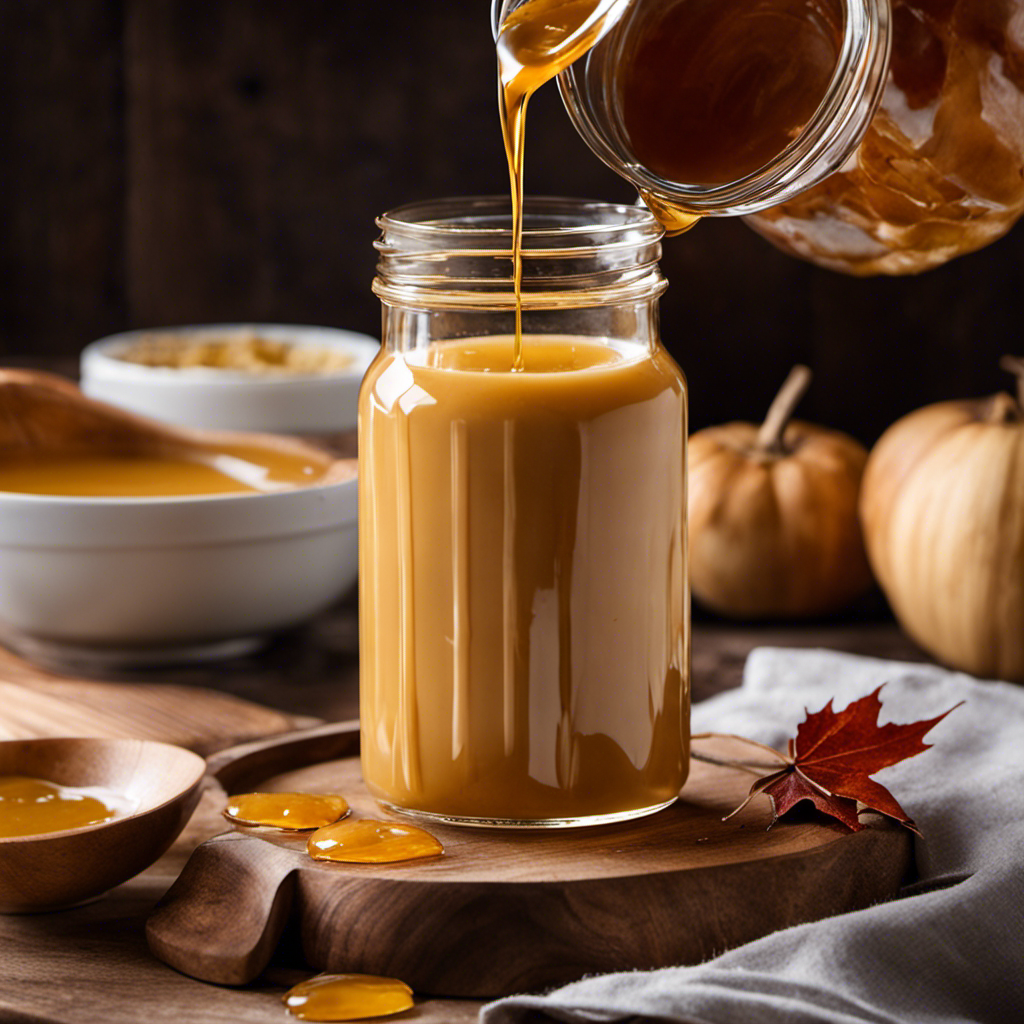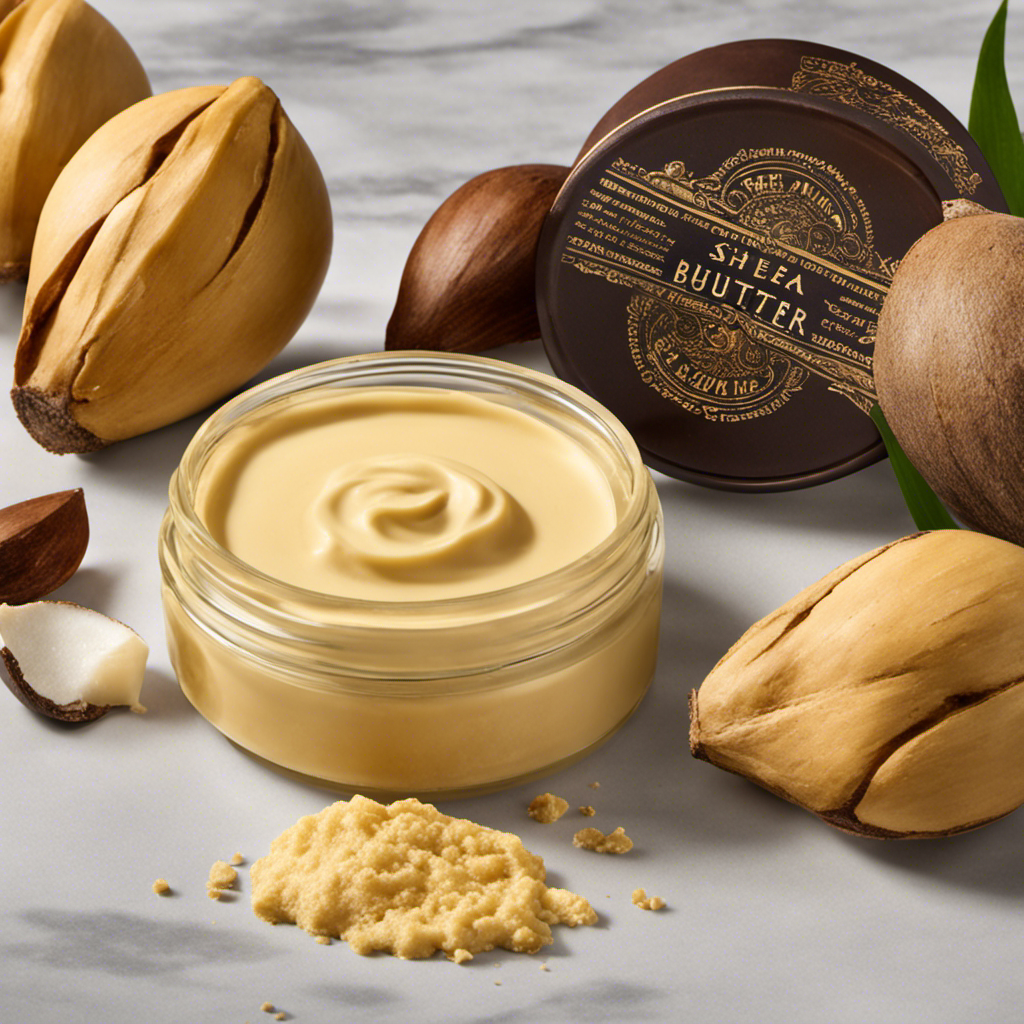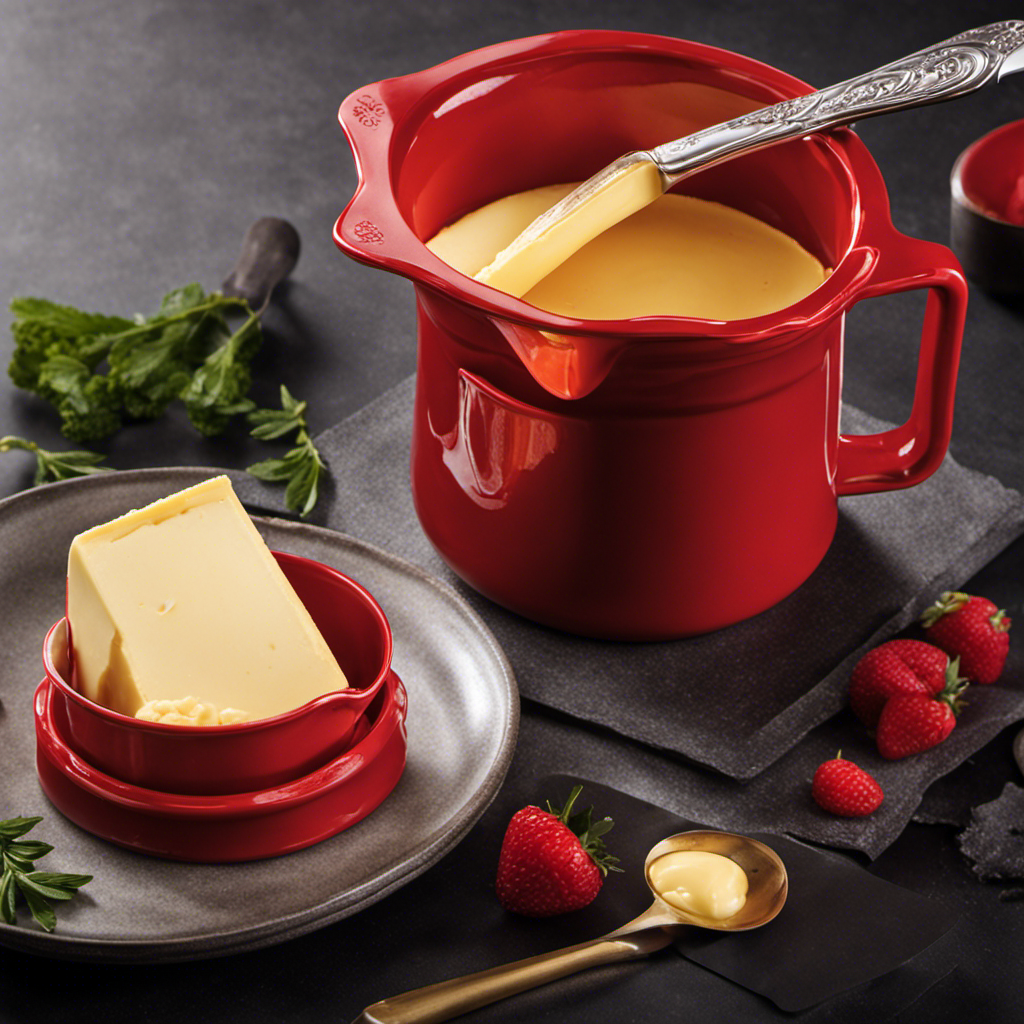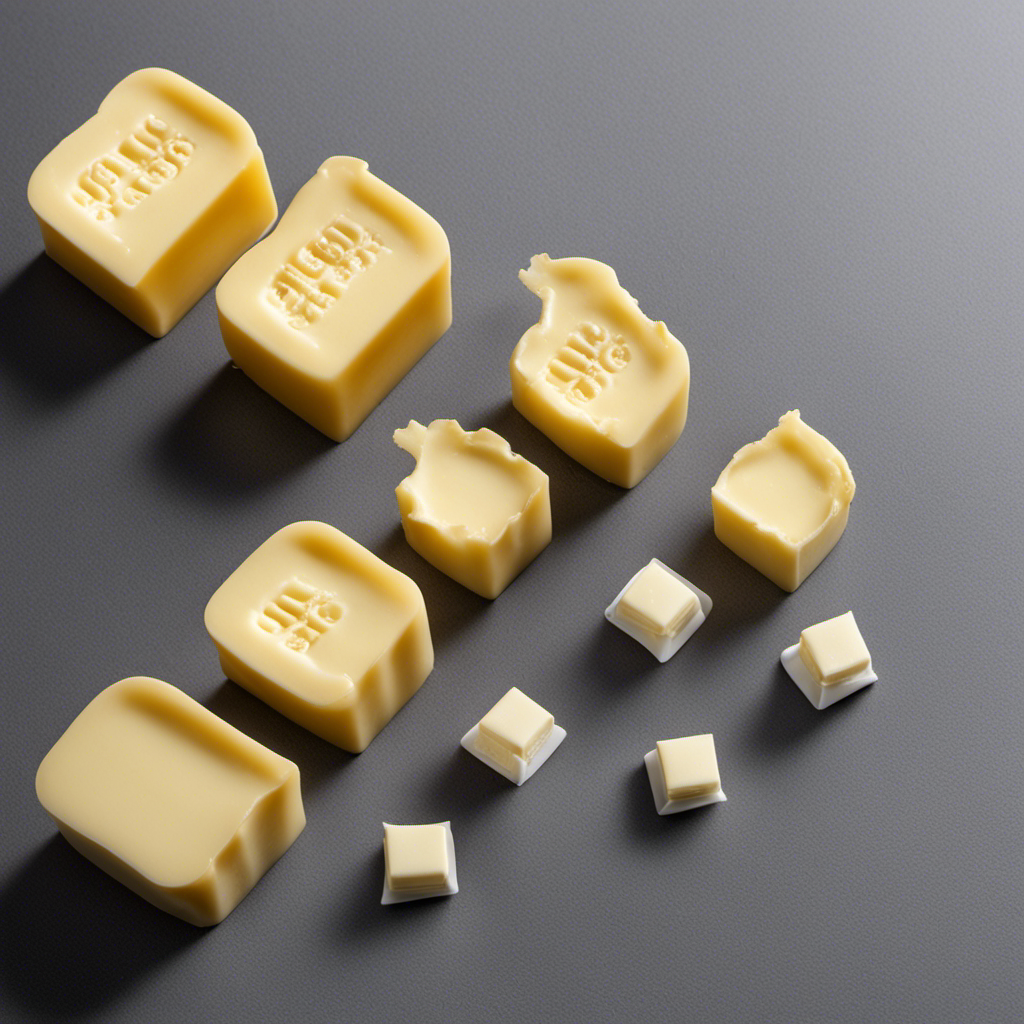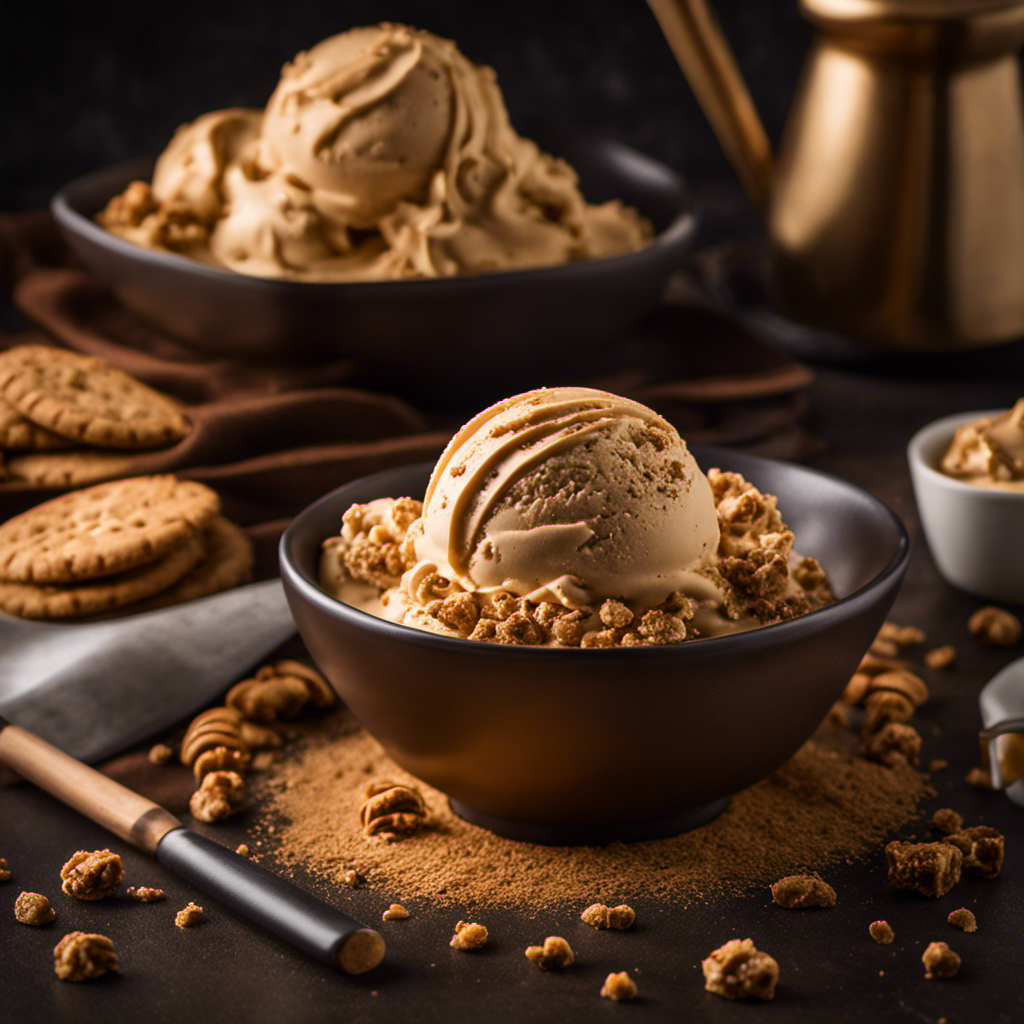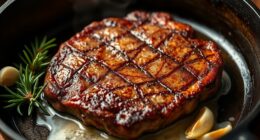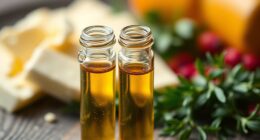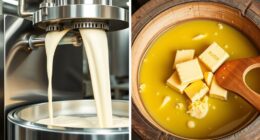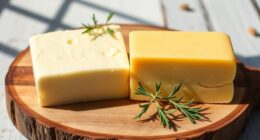You can never have enough of a good thing, as the saying goes. This is especially true when it comes to maple butter.
In this article, I’ll show you how to make this irresistibly creamy and sweet spread right in the comfort of your own kitchen.
With just a few simple steps and some basic ingredients, you’ll have a delectable treat that will elevate your breakfasts, desserts, and everything in between.
So, let’s dive in and satisfy our taste buds with homemade maple butter.
Key Takeaways
- Melting the butter using a double boiler or low heat setting is essential for making maple butter.
- Maple syrup is the key ingredient in maple butter, but alternatives like honey or agave nectar can be used for different flavor variations.
- Proper storage in the refrigerator is necessary to keep maple butter fresh for several weeks.
- Maple butter can be used in various ways, such as pairing with grilled chicken or roasted vegetables, topping warm bread, drizzling over pancakes or waffles, and mixing into frosting for cakes or cupcakes.
Gathering the Ingredients
First, you’ll need to gather all of the necessary ingredients for making maple butter. To start, you’ll want to make sure you have high-quality maple syrup. There are different variations of maple syrup, such as Grade A Dark Amber or Grade B, each with its own distinct flavor profile. Depending on your preference, you can choose the one that suits your taste best.
Additionally, you’ll need unsalted butter, preferably at room temperature, to ensure easy mixing and creamy texture. When it comes to melting the butter, it’s important to use optimal techniques to avoid burning or scorching. A double boiler is ideal for this, as it provides gentle, indirect heat.
Once you have all the ingredients ready, we can move on to the equipment needed for making maple butter.
Equipment Needed
To prepare this delicious spread, you’ll need a mixer and a saucepan. These two essential pieces of equipment will help you create the perfect maple butter.
First, let’s talk about the mixer. You’ll want to set it to its lowest speed, as we don’t want to incorporate too much air into the mixture. This will help us achieve that smooth and creamy texture we’re aiming for.
As for the saucepan, it’s important to choose one that is large enough to hold all the ingredients and has a sturdy handle for easy pouring. When melting the butter, it’s crucial to keep it at an optimal temperature, around 120°F to 140°F, to ensure a smooth and even consistency.
Using gentle melting techniques, like a double boiler or a low heat setting, will help prevent any scorching or separating of the butter.
Step 1: Melting the Butter
When it comes to melting butter, there are a few techniques that can be used to achieve the perfect consistency.
One method is using a double boiler, which involves placing a heatproof bowl over a pot of simmering water. This gentle heat helps to ensure that the butter melts evenly and without burning.
Another option is melting the butter in the microwave, which is quick and convenient but requires careful monitoring to prevent overheating.
The optimal melting temperature for butter is around 90°F to 95°F, as this allows it to become completely liquid without separating or losing its desirable properties.
Butter Melting Techniques
If you want to melt the butter for your maple butter, start by placing it in a microwave-safe bowl.
There are different methods for melting butter, each offering its own benefits.
One popular technique is browning the butter, which adds a rich, nutty flavor to your maple butter. To do this, simply melt the butter in a saucepan over medium heat and continue cooking until the milk solids turn golden brown.
Another method is butter clarifying, which involves removing the milk solids and water from the melted butter. This results in a clear, pure butter that is perfect for making maple butter.
Regardless of the technique you choose, it’s important to melt the butter at an optimal temperature. This ensures that the butter is fully melted and doesn’t become too hot or burn.
Optimal Melting Temperature
The optimal temperature for melting butter is crucial to avoid overheating or burning it. When it comes to melting butter, it’s important to use the right cooking utensils and follow the proper melting techniques.
To begin, you’ll need a small saucepan and a heat-resistant spatula. Place the saucepan on low heat and add the butter. Allow it to slowly melt, stirring occasionally with the spatula to ensure even melting. Avoid using high heat as it can cause the butter to burn or turn brown.
The ideal temperature for melting butter is around 140-150°F (60-65°C). At this temperature, the butter will be smooth and creamy, perfect for incorporating other ingredients.
Now that the butter is melted, let’s move on to step 2: adding the maple syrup.
Step 2: Adding the Maple Syrup
Now that you’ve melted the butter, you’ll want to add the maple syrup to the mixture. Maple syrup is a key ingredient in making maple butter, but if you’re looking for alternatives, you can also try using honey or agave nectar for a different flavor profile.
Maple syrup adds a rich, sweet taste to the butter, giving it that distinct maple flavor. Once you’ve added the maple syrup, make sure to mix it well with the melted butter until it is fully incorporated.
Maple butter has a variety of uses, from spreading it on toast or pancakes to using it as a glaze for roasted vegetables or meats. The possibilities are endless!
Now that we’ve added the maple syrup, let’s move on to the next step: mixing the ingredients together.
Step 3: Mixing the Ingredients
Once you’ve added the maple syrup, you’ll want to thoroughly mix the ingredients together until they are well combined. This step is crucial in achieving the perfect maple butter consistency. As you mix, you’ll notice the syrup blending with the softened butter, creating a smooth and creamy texture.
The aroma of the sweet maple syrup begins to fill the room, tantalizing your senses. The rich and velvety flavor of the maple butter is already starting to take shape. You can almost taste the sweetness and warmth on your tongue.
At this stage, you can get creative and add different flavor options to your maple butter. You can experiment with cinnamon, vanilla extract, or even a hint of nutmeg to enhance the taste. Mixing the ingredients together not only ensures a consistent texture but also allows the flavors to meld together, resulting in a decadent spread that will elevate any breakfast or dessert.
Step 4: Heating the Mixture
After you’ve thoroughly mixed the ingredients, you’ll need to heat the mixture to achieve the desired consistency. This step is crucial in transforming the maple syrup and butter into a smooth and velvety spread.
To begin, place a saucepan over medium heat and add the mixture. It’s important to keep a close eye on it as it heats up. The heating time will vary depending on the quantity and the stove, but it typically takes around 10-15 minutes.
As the mixture heats, use a wooden spoon to stir continuously in a gentle figure-eight motion. This stirring technique helps evenly distribute the heat and prevent any scorching.
The maple butter is ready when it thickens slightly and becomes glossy. Once achieved, remove it from the heat and allow it to cool before transferring it into a jar.
Step 5: Cooling and Storing the Maple Butter
When it comes to storing maple butter, choosing the right container is crucial. In my experience, the best storage container for maple butter is a glass jar with an airtight lid. This helps to preserve its rich flavor and creamy texture.
While refrigeration is not necessary, it can help extend the shelf life of the maple butter, keeping it fresh for longer periods of time.
Best Storage Container
To find the best storage container for your homemade maple butter, you should consider using a glass jar with an airtight lid. Glass jars are ideal for storing maple butter because they are non-reactive and won’t absorb any flavors or odors from the butter. The airtight lid will help to keep the butter fresh for longer periods of time by preventing air from entering the container.
Here are some alternative containers you could consider:
-
Plastic containers: While not as ideal as glass, plastic containers with airtight lids can also be used to store maple butter. Just make sure the container is food-safe and BPA-free.
-
Silicone molds: If you prefer individual portions of maple butter, silicone molds are a great option. They are flexible and easy to pop the butter out of once it’s solidified.
Refrigeration Necessary
You should refrigerate your homemade maple butter to keep it fresh for longer periods of time. While there are refrigeration alternatives and homemade butter alternatives out there, refrigeration is still the best method to preserve the quality of your maple butter.
The cool temperature of the refrigerator helps to slow down the growth of bacteria and mold, ensuring that your maple butter stays safe to consume. This is especially important if you’ve made a large batch and want to enjoy it over a longer period. While some may suggest using other methods like freezing or canning, these alternatives may alter the texture and taste of your maple butter. So, to maintain the deliciousness of your homemade maple butter, refrigeration is the way to go.
Now, let’s talk about the shelf life length of your maple butter.
Shelf Life Length?
If stored properly, the shelf life of your homemade maple butter can be extended for several weeks. To ensure the freshness and quality of your maple butter, it is important to store it in the best storage container.
I recommend using airtight glass jars or plastic containers with tight-fitting lids. These containers will help to prevent air and moisture from entering, which can lead to spoilage.
When it comes to refrigeration, it is necessary to keep your maple butter chilled. The cold temperature will help to preserve its flavor and texture. However, if you prefer a softer consistency, you can store it at room temperature for a shorter period of time.
Now that we’ve covered the shelf life, let’s move on to some tips for flavor variations.
Tips for Flavor Variations
Experiment with different spices, like cinnamon or nutmeg, to add a unique twist to your maple butter. Adding spices not only enhances the flavor of the butter but also allows for creative uses in various dishes. Here are some flavor variations and their suggested uses:
| Flavor Variation | Description | Suggested Uses |
|---|---|---|
| Cinnamon | Warm and aromatic spice that pairs well with sweet dishes | Spread on toast, pancakes, or waffles |
| Nutmeg | Rich and slightly sweet spice with a hint of warmth | Incorporate into baked goods or sprinkle on top of hot beverages |
| Ginger | Zesty and slightly spicy spice that adds a refreshing kick | Use in marinades for meats or mix into salad dressings |
| Vanilla | Sweet and creamy spice that complements the natural sweetness of maple | Stir into coffee, yogurt, or oatmeal |
| Cardamom | Floral and aromatic spice with a hint of citrus | Add to smoothies or mix into ice cream |
Serving Suggestions
Looking for ways to enhance your dishes? Try incorporating these flavor variations into your meals for a delightful twist. When it comes to serving ideas and pairing suggestions, there are endless possibilities to elevate your culinary creations. Here are some suggestions to get you started:
-
For a savory dish:
-
Pair a rich and creamy maple butter with grilled chicken or roasted vegetables for a burst of sweetness and depth.
-
Spread maple butter on warm, crusty bread and top it with thinly sliced prosciutto for a delicious appetizer.
-
For a sweet treat:
-
Drizzle maple butter over pancakes or waffles, along with fresh berries and a dollop of whipped cream, for a decadent breakfast or brunch.
-
Mix maple butter into your favorite frosting recipe to add a unique flavor to cakes or cupcakes.
Experiment with these serving ideas and pairing suggestions, and let your taste buds take you on a mouthwatering journey.
Frequently Asked Questions
When it comes to making maple butter, there are a few key points to consider.
First, the ingredients. Maple butter typically consists of just two ingredients: maple syrup and butter.
Second, the cooking temperature. It’s important to heat the mixture to a specific temperature to ensure the butter and syrup combine properly.
Lastly, the shelf life. Maple butter can be stored in the refrigerator for several weeks, but it’s best to consume it within a month for optimal freshness.
Maple Butter Ingredients
To make maple butter, you’ll need butter, maple syrup, and a pinch of salt. Maple butter is a delicious spread that adds a sweet and rich flavor to any dish.
However, if you’re looking for alternatives or want to experiment with different flavors, there are a few options you can try:
- Honey butter: Substitute the maple syrup with honey for a different twist on the classic recipe.
- Cinnamon butter: Add a teaspoon of ground cinnamon to the mixture for a warm and aromatic flavor.
When it comes to sweet vs. savory maple butter recipes, the possibilities are endless. For a sweet option, you can add a drizzle of caramel sauce or a sprinkle of powdered sugar. On the other hand, if you prefer a savory twist, you can mix in some herbs like rosemary or thyme, or even a hint of garlic for a unique and tasty spread.
Cooking Temperature for Maple Butter
If you’re wondering about the cooking temperature, be sure to keep it low and slow to prevent the butter from burning and to allow the flavors to meld together perfectly. Cooking maple butter requires patience and precision. I have tested different temperatures to find the ideal one for achieving the best results. Here’s what I discovered:
| Temperature (°F) | Result | Notes |
|---|---|---|
| 200 | Too low | Butter didn’t fully melt and flavors didn’t develop |
| 250 | Perfect | Smooth and creamy texture with rich maple flavor |
| 300 | Too high | Butter started to brown and taste slightly burnt |
Shelf Life of Maple Butter
The shelf life of maple butter can vary depending on storage conditions and the presence of any additives. Properly stored, maple butter can last for several months, maintaining its rich flavor and smooth texture. Here are some key factors that can affect the shelf life of maple butter:
-
Storage conditions:
-
Keep maple butter in a cool, dry place away from direct sunlight.
-
Store it in an airtight container to prevent exposure to air and moisture.
-
Additives:
-
Avoid adding any perishable ingredients, such as fresh fruit or dairy products, to your maple butter recipes.
-
These additives can shorten the shelf life and increase the risk of spoilage.
Preserving maple butter is essential to enjoy its delightful taste for longer. By following these tips, you can ensure that your homemade maple butter stays fresh and delicious for as long as possible.
Troubleshooting Tips
One common issue when making maple butter is that it can turn out too runny if the butter is too soft. But don’t worry, there are a few troubleshooting techniques that can help you achieve the perfect consistency.
First, make sure to use cold butter. Soft butter will not emulsify properly with the maple syrup, resulting in a runny texture.
Another common mistake is adding too much maple syrup. While it may be tempting to add extra sweetness, too much syrup can make the butter too thin. Start with a small amount and gradually add more until you achieve the desired flavor.
Lastly, be patient when mixing. Slowly incorporate the syrup into the butter, allowing it to blend together thoroughly.
Frequently Asked Questions
How Long Does It Take for the Maple Butter to Cool and Solidify?
It takes about an hour for the maple butter to cool and solidify. Once it’s ready, the texture of the solidified butter is smooth and creamy, perfect for spreading on toast or pancakes.
Can I Use Margarine Instead of Butter for This Recipe?
Yes, you can use margarine instead of butter for this recipe. It will still give you a creamy texture for your maple butter. Just follow the same steps as with butter.
Can I Use Pancake Syrup Instead of Maple Syrup?
Yes, you can use pancake syrup instead of maple syrup. However, I recommend using real maple syrup for its rich flavor and natural sweetness. It adds a unique taste that can enhance your recipe.
How Long Can I Store Maple Butter in the Refrigerator?
Maple butter can be stored in the refrigerator for up to three months. However, for longer shelf life, you can also freeze it. Just make sure to use airtight containers to maintain its freshness and flavor.
Can I Use Salted Butter Instead of Unsalted Butter for This Recipe?
Yes, you can use salted butter instead of unsalted butter for the maple butter recipe. The salted butter will add a hint of savory flavor to the sweet maple, creating a delicious combination.
Conclusion
In conclusion, making maple butter is a simple and delicious way to elevate your breakfast or dessert. By melting butter and adding maple syrup, you create a creamy and sweet spread that will leave your taste buds wanting more.
Whether you choose to enjoy it on toast, pancakes, or even in your morning coffee, maple butter is sure to add a touch of indulgence to any dish. Just imagine the perfect stack of fluffy pancakes, topped with a generous dollop of maple butter, and drizzled with warm maple syrup. Pure bliss!
